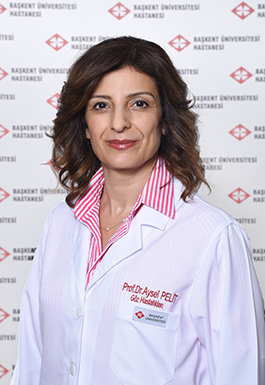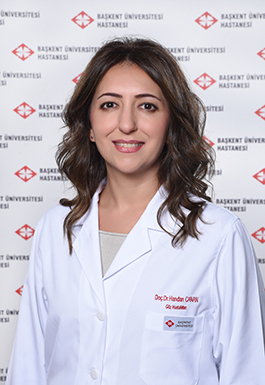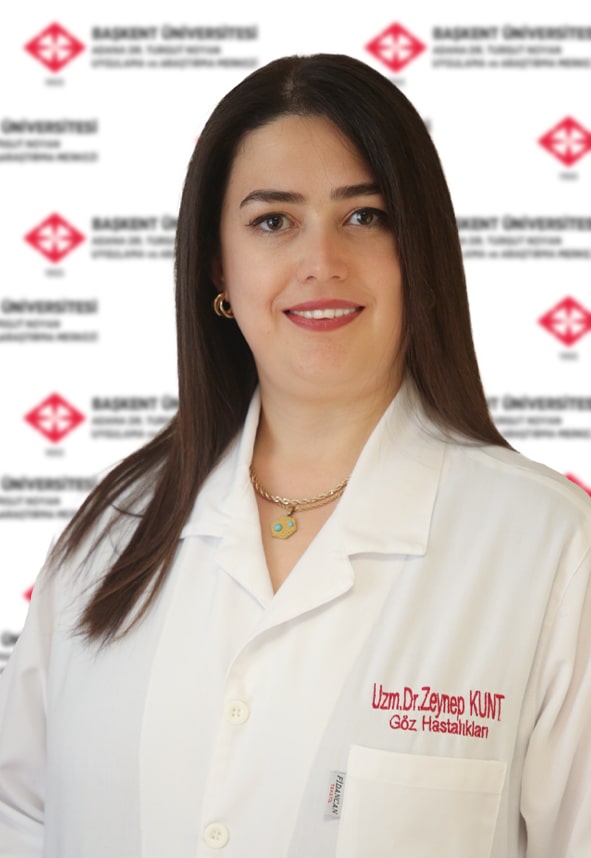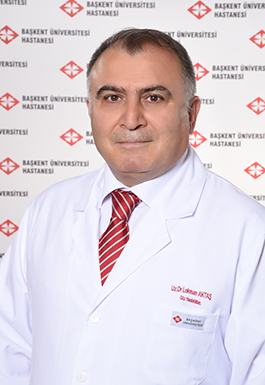Our Department of Ophthalmology
In our Department of Ophthalmology, we conduct diagnostic and treatment activities for all kinds of eye diseases. We offer both outpatient and inpatient treatment services.
Cornea and Ocular Surface Diseases
* Corneal Infections
* Keratoconus
* Pterygium
* Glaucoma - Eye Pressure
* Cataract
* Uveitis
* Retinal Vascular Diseases
* Age-Related Macular Degeneration – Yellow Spot Disease
* Retinopathy of Prematurity (ROP)
* Strabismus and Amblyopia
* Eyelid and Tear System Diseases – Oculoplastic Surgery
Cornea and Ocular Surface Diseases
The cornea is the transparent layer at the front of the eyeball. It functions as a window allowing light to pass to the retina and serves as a protective membrane. Corneal diseases can cause symptoms like burning, stinging, redness, light sensitivity, and visual disturbances such as spotting and blurred vision. Diseases like keratoconus, hereditary corneal dystrophies, age-related corneal degenerations, infectious diseases of the cornea, dry eye, allergic conjunctivitis, infectious conjunctivitis, and pterygium are evaluated under this category. These diseases, which can cause clinical pictures varying from discomfort and pain in the eye to loss of vision, require detailed examination. In addition to the examination, auxiliary methods such as tear function tests, corneal surface mapping, and measuring corneal thickness are used in the diagnosis and follow-up of these diseases. Some common diseases include:
Corneal Inflammations
Keratitis, inflammation of the cornea, can develop due to bacteria, fungi, viruses, and parasites. It begins with symptoms such as conjunctival hyperemia, photophobia, and sudden onset pain. Immediate consultation with an eye doctor and initiation of treatment is necessary. Similar clinical pictures can also be seen following various systemic diseases and conditions affecting eyelid function, such as facial paralysis.
Keratoconus
Keratoconus is characterized by thinning of the cornea and its forward bulging, taking on a conical shape. It usually affects both eyes, though it may be more advanced in one eye. The disease progresses more rapidly during adolescence. As keratoconus advances, the thinning and irregular astigmatism in the central cone increase. Some patients may experience acute corneal edema due to tearing, known as acute hydrops.
In early cases of keratoconus, visual acuity is usually correctable with glasses. However, as keratoconus progresses, it is necessary to neutralize irregular astigmatism with gas-permeable or hybrid contact lenses to improve visual acuity. Nowadays, positive results are reported with collagen cross-linking and intrastromal corneal rings. If these methods are insufficient, penetrating keratoplasty is performed to replace the central conical scarred cornea with a transparent cornea.
Cross-linking treatment is also performed in our clinic.
Pterygium
Commonly known as “surfer’s eye,” pterygium is a condition where the conjunctiva, a membranous layer covering the eye surface, extends over the cornea, causing a “flesh” appearance. It causes not only cosmetic problems but also blurring of vision due to irregular astigmatism. Sunlight is a contributing factor in its formation. This condition is frequently encountered in our region. There is no treatment other than surgery. Although the risk of recurrence after surgery is high, this risk can be reduced with techniques such as transplanting a patch from another part of the eye and using certain medications.
Glaucoma - Eye Pressure
Glaucoma is a disease characterized by progressive damage to the optic nerve, visual field losses, and high intraocular pressure. It is one of the preventable causes of blindness worldwide. If glaucoma is diagnosed and treated in time, vision loss can be prevented. It is often referred to as “black water disease” in the public. The disease progresses without symptoms in about 90% of cases and is often "accidentally" discovered during routine eye examinations. There are no specific symptoms for glaucoma, but if vision loss has progressed significantly in the advanced stages, it may be noticeable. Early visual field losses are usually not detected by the patient, and even severe visual field losses may go unnoticed. Since glaucoma does not show significant symptoms in the early stages, it can only be diagnosed after a thorough eye examination. Therefore, it is recommended that every individual over 40 years of age, and those with a family history of glaucoma, over 30, undergo a yearly eye examination.
The main risk factor for glaucoma is high intraocular pressure. The intraocular pressure increases due to resistance to the outflow of eye fluid for various reasons. In the general population, intraocular pressure values range between
10 and 21 mmHg, and not everyone with high intraocular pressure has glaucoma. There can be a slight increase in intraocular pressure with advancing age.
It was previously thought that high intraocular pressure was the only factor causing glaucoma. However, the observation of progressive visual field damage in some patients with normal intraocular pressure indicated that intraocular pressure is not the sole cause of this disease. Therefore, to diagnose glaucoma, simply measuring high intraocular pressure is not sufficient. Changes in the optic nerve head should be identified by examination, and visual field defects, if any, should also be demonstrated. Intraocular pressure must be measured with a Goldmann tonometer and adjusted according to the thickness of the corneal layer. Several measurements at different times are required. The non-contact (air-puff) method is suitable for screening but not sufficient for the diagnosis and follow-up of glaucoma.
Angle-closure glaucoma, a less common type of glaucoma, can cause symptoms such as eye pain, blurred vision, and nausea and vomiting.
In the monitoring and determination of optic nerve damage in glaucoma, advanced technology diagnostic devices are used. Our glaucoma specialist physicians interpret the data from these devices to plan the patient's treatment. These include visual field devices that show the extent of vision loss due to damage to the optic nerve and OCT (optical coherence tomography) devices that analyze the optic nerve and nerve fibers, and they are crucial in diagnosing and planning the treatment of glaucoma.
The most important goal in treatment is to stop the progression of the disease. The methods used aim to either reduce the production of intraocular fluid or increase its outflow from the eye. In the treatment of glaucoma, it is aimed to keep the intraocular pressure at a certain level. Various eye drops are used either alone or in combination for this purpose. The treatment is lifelong, and regular check-ups are required.
In cases where drug treatment is not sufficient to control intraocular pressure, laser and surgical treatments are considered. The aim of surgery is to ensure the continuous outflow of intraocular fluid, which is produced continuously in glaucoma and inadequately drained through normal channels, by placing it under the outer membranous layer (conjunctiva) of the eye and draining it through the vascular network there. This is achieved by traditional surgery (trabeculectomy) or increasingly common tube placement (seton) surgeries, both of which are performed in our hospital.
Cataract
Commonly known as “waterfall disease,” cataract is the loss of transparency of the lens, becoming opaque. The most common complaints of patients are reduced vision, blurry vision, halos around objects, discomfort from bright light, and glare. Cataract most commonly occurs due to advancing age, but it can also be caused by medications, other systemic diseases, and trauma to the eye (traumatic cataract), and congenital cataract is also possible.
There is no treatment for cataract other than surgery. The most advanced technology currently used worldwide, "phacoemulsification" (commonly referred to as phaco), is also extensively used in our hospital.
As mentioned above, there is no treatment for cataract other than surgery, and ultrasound energy is used in surgery. The use of advanced technology in surgery, the ability to perform the surgery through a small incision, and the absence of stitches have led to the misconception that the surgery is performed with a laser.
Cataract surgery is necessary when at least one of the symptoms such as reduced visual acuity, blurry vision, halos around objects, discomfort from bright light, and glare is present, and when these symptoms start to affect the individual's daily life. The approach of waiting for the cataract to fully mature and vision to decrease significantly has been abandoned in modern times.
Uveitis
Uveitis, the inflammation of the uveal layer, the vascular layer of the eye, presents with a wide and variable clinical picture. Various rheumatological diseases, tuberculosis, sarcoidosis, certain infectious diseases, and Behçet's disease, which is very important for our country, can present with a uveitis picture. Apart from these, there are also uveitis cases whose cause has not yet been fully elucidated. If left untreated, uveitis can lead to complications up to complete vision loss.
At our hospital, the diagnosis and follow-up of uveitis patients are conducted with advanced laboratory facilities and imaging methods, along with multidisciplinary collaboration with other specialties.
Retinal Vascular Diseases
Some diseases, such as diabetes mellitus (diabetes), hypertension, and sickle cell anemia, can cause structural changes in the eye's blood vessels, leading to vision loss. Since these changes are mostly irreversible, prevention and early diagnosis are very important.
Patients with these conditions should carefully follow the recommendations of their internal medicine specialist. Keeping blood sugar, hypertension, and
blood lipid levels under control will delay or slow down the effects on the eyes. It is very important for patients with diabetes mellitus and hypertension to have annual eye check-ups. Even after eye involvement occurs, patients should be checked as often as recommended by the ophthalmologist. These check-ups include a thorough eye examination, followed by a detailed examination of the eye fundus (vessels and nerves) after dilating the pupils with drops. In addition, fundus fluorescein angiography (eye angiography) should be performed periodically in patients who require it. Following the injection of 5 ml of fluorescein into a vein in the hand or arm, photos of the back of the eye are taken at regular intervals. The obtained images allow for a more detailed examination of the vascular structure, making visible some details that cannot be seen during the examination. Patients with any history of allergies should inform their doctor before the procedure, as the injected substance can cause allergic reactions. Yellowing of the skin and yellow urine may occur in the first 24 hours after angiography. Angiography is diagnostic only and may need to be repeated periodically.
Age-Related Macular Degeneration – Yellow Spot Disease
Age-related macular degeneration, a leading cause of blindness worldwide, is a disease of advanced age. Although its cause has not been fully clarified, nutrition, sunlight, and smoking are blamed as factors. The more common, slowly progressing "dry" type usually affects the quality of vision but does not lead to vision loss. The less common "wet" type, on the other hand, rapidly leads to vision loss.
The treatment aims to preserve vision. The newest method applied all over the world and in our hospital for this purpose is the administration of "anti-VEGF" drugs into the eye, which prevent the formation of new blood vessels. This treatment is frequently applied in our clinic. Regular injections are made into the eye at certain intervals. Patients are followed up with examinations and angiography. In addition, it is known that commercial preparations containing certain vitamins, trace elements, and antioxidants also slow down the course of the disease.
Premature Retinopathy (ROP)
Premature Retinopathy (ROP) is a developmental anomaly of the retina (the nerve layer of the eye) vessels in premature infants, especially those with low birth weight and those who have received treatment in neonatal intensive care units. The likelihood and severity of the disease increase as the baby's birth weight and/or gestational age decrease. Retinal vessels, accustomed to the relatively low oxygen environment in the womb, are exposed to high oxygen levels in the external environment before completing their maturation processes, leading to developmental disruptions. Excessively fragile, bleeding-prone, and weak vessels cause functional disturbances in the retina and, consequently, various degrees of vision loss. The clinical presentation can range from high myopia and strabismus to complete blindness.
Early detection of the condition is crucial for preventing or minimizing potential damage. Therefore, infants born before 42 weeks of gestation and/or weighing less than 2000 grams should undergo detailed retinal examinations at regular intervals while in the neonatal intensive care unit and after discharge until their retinal development is complete. Early diagnosis plays a significant role in the course of the disease.
While mild cases can resolve spontaneously, severe cases require laser photocoagulation. The laser treatment is performed under general anesthesia and applied to the unvascularized parts of the retina.
In cases effectively treated with laser, ROP usually resolves completely. However, these infants can experience eye problems such as high myopia and strabismus in the later stages. Therefore, these infants require long-term careful monitoring. ROP monitoring and treatment have been conducted in our clinic for many years.
Strabismus and Amblyopia
Strabismus is the loss of parallelism and simultaneous movement in the same direction of both eyes. Strabismus can be caused by various factors, including illnesses during the mother's pregnancy, birth complications, congenital metabolic diseases, disorders involving the central nervous system, the eye's own disorders, febrile diseases during infancy or childhood, and a family history of strabismus. In adults, strabismus generally results from eye disorders or central nervous system events.
The most common symptom of strabismus is the misalignment of one or both eyes. Other symptoms may include blurred vision, loss of depth perception, double vision, headaches, and the development of head and facial positions in some types of strabismus. In young children, pseudoesotropia may be present due to a flat nasal bridge and skin folds at the eye corners. This condition is not strabismus and can be easily distinguished by examination. Cases of strabismus may require correction with glasses or surgery.
What is Amblyopia?
Amblyopia, commonly known as lazy eye, occurs when vision deficiency in one or both eyes becomes permanent due to not being corrected in time. High refractive errors in one or both eyes, a significant difference in refractive errors between the two eyes, opacity of the media such as cataract, and strabismus can lead to amblyopia. The primary goal in treatment is to eliminate and rehabilitate the causative factor. The earlier the treatment for amblyopia begins, the more satisfactory the results will be. Therefore, it is important for children to be examined by no later than 2.5-3 years of age. Our clinic provides treatments to help correct amblyopia.
Eyelid and Tear System Diseases – Oculoplastic Surgery
Conditions such as eyelid drooping (ptosis), eyelids turning outwards (ectropion), inwards (entropion), eyelash contact with the eye (trichiasis), eyelid bagging, eyelid tumors can be corrected with oculoplastic surgery. These conditions can result from aging, trauma, burns, scarring diseases, masses, and other various causes. Not only do they create cosmetic issues, but they also disrupt the structure of the eye surface, necessitating correction. All eyelid surgeries are performed in our clinic.
Ptosis: Drooping of the eyelids. It can be congenital or develop post-trauma and in advanced age. In mild cases, correction is done for aesthetic concerns, while in severe cases, it is necessary to correct the condition as it affects vision function.
Ectropion: This condition is characterized by the outward turning of the eyelid, exposing the conjunctiva. Ectropion often occurs due to aging but can also result from eyelid injuries, paralysis of the muscles controlling the eyelids, and certain tumoral formations on the eyelid. Ectropion cases are more susceptible to external factors, leading to tearing, pain, and redness. The eyelid is surgically brought back to its normal position.
Entropion: The inward turning of the eyelid. It causes the lashes to contact the eye, leading to tearing, stinging, burning, and pain. Treatment is surgical.
Chalazion: Chronic infection of the eyel
id's oil glands. Applying warm compresses to the eye can accelerate healing. Medical treatment is also possible. If it does not heal despite all interventions, a simple surgical procedure can be performed to remove the chalazion.
Eyelid Tumors
History and clinical examination can give an idea about the type of tumor. The tumor may present with painless growth, crusting, color changes, bleeding, disruption of eyelid contour, and lash loss. Benign masses are commonly encountered in the eye region. When removing the tumor, a part or the entire eyelid may need to be removed, so the challenge lies not in tumor treatment but in reconstructing the eyelid without disrupting eye functions. Surrounding tissues or a part of the healthy eyelid may be used for this purpose. The surgery is usually done under local anesthesia and may require the eye to be kept closed for a while.
Diagnostic Methods Used in Our Department
- Autorefractor-Keratometer: Measures the eye's refractive values using a computer.
- Pediatric Autorefractor: Determines refractive errors in child patients without causing discomfort.
- Goldmann Tonometry: Measures intraocular pressure based on the applanation principle, using a lens.
- Air Puff Tonometry: More comfortable for patients, it measures eye pressure without contact.
- Phacometer: Used to determine the diopter values and focal points of eyeglass lenses.
- Phoropter: Used in the objective and subjective examination of refractive errors, for prescribing glasses and evaluating visual acuity.
- Pachymeter: Assesses corneal thickness. Essential in evaluating intraocular pressure in glaucoma patients, besides being useful in various diseases.
Computerized Visual Field Testing
A crucial test for glaucoma patients, optic nerve inflammation and edema, various brain tumors, and disorders.
- Optical Coherence Tomography (OCT): Allows examination of the front and back segments of the eye using the Optovue brand.
- Corneal Topography Device: The Orbscan II maps the cornea, the transparent layer at the front of the eye.
- Biometry Device: Used to calculate the power of the intraocular lens to be placed during cataract surgery.
- Ultrasonography: In cases where the eye media is opaque, ultrasonography (both A and B-mode) can assess intraocular masses, hemorrhages, retinal tears, and the presence of foreign bodies.
- Fundus Fluorescein Angiography: Useful in evaluating retinal and macular diseases. A fluorescein substance injected into a vein in the arm colors the retinal vessels.
- Indocyanine Green Angiography: Colors the retinal and choroidal vessels, particularly helpful in inflammatory eye diseases.
Hess Screen: Used in the assessment of eye deviations, eye muscle paralysis, and eye movement disorders.
Nd-YAG Laser: Used in diseases like secondary cataract and angle-closure glaucoma.
Argon Laser: Used in retinal disorders caused by diabetes and various vascular occlusions.
Treatment Methods
- Cornea
- Glaucoma
- Cataract
- Retinal Vascular Diseases
- Age-Related Macular Degeneration (Yellow Spot Disease)
- Premature Retinopathy (ROP)
- Strabismus
Cornea
Treatment of corneal diseases and dry eye usually involves the use of locally applied medications such as eye drops and ointments. In some cases, laser treatment may be required. Various laser treatments are performed in our clinic. However, laser surgery aimed at completely eliminating the need for glasses is not performed in our clinic. Treatments for keratoconus patients, such as contact lens therapy and cross-linking, are provided.
Glaucoma
The primary goal in the treatment of glaucoma is to halt the progression of the disease. The aim is to maintain the intraocular pressure at a certain level. This is achieved through the use of various eye drops, either alone or in combination. The effectiveness of the medication is assessed by regular patient check-ups while under treatment.
In some cases, laser treatment may be used either as a first step or when medication alone is insufficient.
If medical treatment does not adequately control intraocular pressure, surgical treatment is considered. The goal of surgery is to facilitate the drainage of the continuously produced intraocular fluid, which is inadequately expelled in glaucoma, by diverting it beneath the outermost layer of the eye (conjunctiva) where it can be absorbed into the blood vessels. The traditional surgery (trabeculectomy) or the increasingly popular tube insertion surgery (seton) are also performed in our hospital.
Cataract
In phacoemulsification, a very small incision (2.2-2.8 mm) is made; the lens, within its capsule, is fragmented using ultrasound energy and then aspirated. A permanent artificial intraocular lens is then placed in the resultant potential space. The incision typically heals by itself without the need for stitches at the end of the surgery. As with many eye surgeries, unless necessary, the patient does not receive general anesthesia but is instead anesthetized with eye drops and/or a needle around the eye.
In our hospital, intraocular lenses approved by clinical studies and recognized by relevant authorities (Turkish Ministry of Health, US Food and Drug Administration) are used in cataract surgery.
Retinal Vascular Diseases
Laser treatment: In diseases such as diabetic or hypertensive retinopathy, or in retinal vascular diseases, laser treatment is administered to prevent the progression of the condition. The primary goal of laser treatment is to prevent new bleeding. It is usually performed in several sessions. Laser treatment is intended to halt the progression of the disease; it is not sufficient on its own.
Anti-VEGF Treatment - Medication to reduce new blood vessel formation: As an alternative or in addition to laser, some drugs are directly injected into the eyeball. These drugs, which prevent new vessel formation or reduce swelling in the central vision area, are generally administered in operating room conditions. However, these drugs do not always show absolute effectiveness and may require repeated injections.
Age-Related Macular Degeneration (Yellow Spot Disease)
The aim of the treatment for yellow spot disease is to preserve vision. The most current method, administered worldwide and in our hospital, involves the injection of “anti-VEGF” drugs into the eye, which prevent new blood vessel formation. This treatment is regularly applied at certain intervals and patients are followed up with examinations, optical coherence tomography, and angiography.



